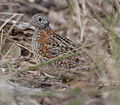Buttonquail
| Buttonquail | |
|---|---|

| |
| Black-breasted buttonquail (Turnix melanogaster) | |
| Scientific classification | |
| Domain: | Eukaryota |
| Kingdom: | Animalia |
| Phylum: | Chordata |
| Class: | Aves |
| Order: | Charadriiformes |
| Family: | Turnicidae Gray, GR, 1840 |
| Type species | |
| Tetrao gibraltaricus[1] Gmelin, 1788
| |
| Genera | |
| |

| |
| Distribution of the buttonquails | |
Buttonquail or hemipodes are members of a small family of
Buttonquails are small, drab, running birds, which avoid flying. The female is the more richly colored of the sexes. While the quail-plover is thought to be monogamous, Turnix buttonquails are sequentially
Taxonomy
The genus Turnix was introduced in 1791 by French naturalist in Pierre Bonnaterre.[2] The genus name is an abbreviation of the genus Coturnix.[3] The type species was subsequently designated as the common buttonquail.[4]
The buttonquail family, Turnicidae, was introduced in 1840 by the English zoologist
Description
The buttonquails are a group of small terrestrial birds. The smallest species is the quail-plover, the only species in the genus Ortyxelos, which is 10 cm (3.9 in) in length and weighs only 20 g (0.71 oz). The buttonquails in the genus Turnix range from 12 to 23 cm (4.7–9.1 in) in length and weigh between 30 and 130 g (1.1–4.6 oz). They superficially resemble the true quails of the genus Coturnix, but differ from them in lacking a hind toe and a crop. The females of this family also possess a unique vocal organ created by an enlarged trachea and inflatable bulb in the esophagus, which they use to produce a booming call.[10]
Breeding
Buttonquails are unusual in that females are serially polyandrous. The nest is a scape on the ground often near overhanging vegetation. The female lays a clutch of 4 or 5 eggs and then looks for a new mate. The male incubates the eggs which hatch synchronously after 12 to 15 days. The precocial chicks leave the nest soon after hatching and are cared for by the male. They can fly at two weeks of age and become independent at four weeks. For the smaller species sexual maturity is reached at three months.[10]
Species
Family: Turnicidae
- Genus: Ortyxelos
- Quail-plover, Ortyxelos meiffrenii
- Genus: Turnix
- Common buttonquail, Turnix sylvaticus
- Tawitawi small buttonquail, Turnix sylvaticus suluensis (extinct: mid-20th century)
- Andalusian hemipode, Turnix sylvaticus sylvaticus (possibly extinct: late 20th century?)
- Tawitawi small buttonquail, Turnix sylvaticus suluensis (
- Red-backed buttonquail, Turnix maculosus
- Fynbos buttonquail, Turnix hottentottus
- Black-rumped buttonquail, Turnix nanus
- Yellow-legged buttonquail, Turnix tanki
- Spotted buttonquail, Turnix ocellatus
- Barred buttonquail, Turnix suscitator
- Madagascar buttonquail, Turnix nigricollis
- Black-breasted buttonquail, Turnix melanogaster
- Chestnut-backed buttonquail, Turnix castanotus
- Buff-breasted buttonquail, Turnix olivii
- Painted buttonquail, Turnix varius
- Abrolhos painted buttonquail, Turnix varius scintillans
- New Caledonian buttonquail, Turnix novaecaledoniae (possibly extinct: early 20th century)
- Worcester's buttonquail, Turnix worcesteri
- Sumba buttonquail, Turnix everetti
- Red-chested buttonquail, Turnix pyrrhothorax
- Little buttonquail, Turnix velox
- Common buttonquail, Turnix sylvaticus
Gallery
-
Barred buttonquail (Turnix suscitator)
-
Small buttonquail(Turnix sylvatica)
-
Painted buttonquail (Turnix varia)
-
Red-chested buttonquail (Turnix pyrrhothorax)
References
- ^ "Alcidae". aviansystematics.org. The Trust for Avian Systematics. Retrieved 2023-07-26.
- ISBN 978-0-9568611-1-5.
- ISBN 978-1-4081-2501-4.
- ^ Peters, James Lee, ed. (1934). Check-List of Birds of the World. Vol. 2. Cambridge, Massachusetts: Harvard University Press. p. 142.
- ^ Gray, George Robert (1840). A List of the Genera of Birds : with an Indication of the Typical Species of Each Genus. London: R. and J.E. Taylor. p. 63.
- ^ Bock, Walter J. (1994). History and Nomenclature of Avian Family-Group Names. Bulletin of the American Museum of Natural History. Vol. 222. New York: American Museum of Natural History. pp. 112, 178, 237.
- PMID 13678682.
- S2CID 1296408. Archived from the original(PDF) on 2013-04-07.
- ^ PMID 16531074.
- ^ ISBN 978-84-87334-20-7.
- Ahlquist, Jon Edward(1990): Phylogeny and classification of birds. Yale University Press, New Haven, Conn.
External links
- Buttonquail videos on the Internet Bird Collection




